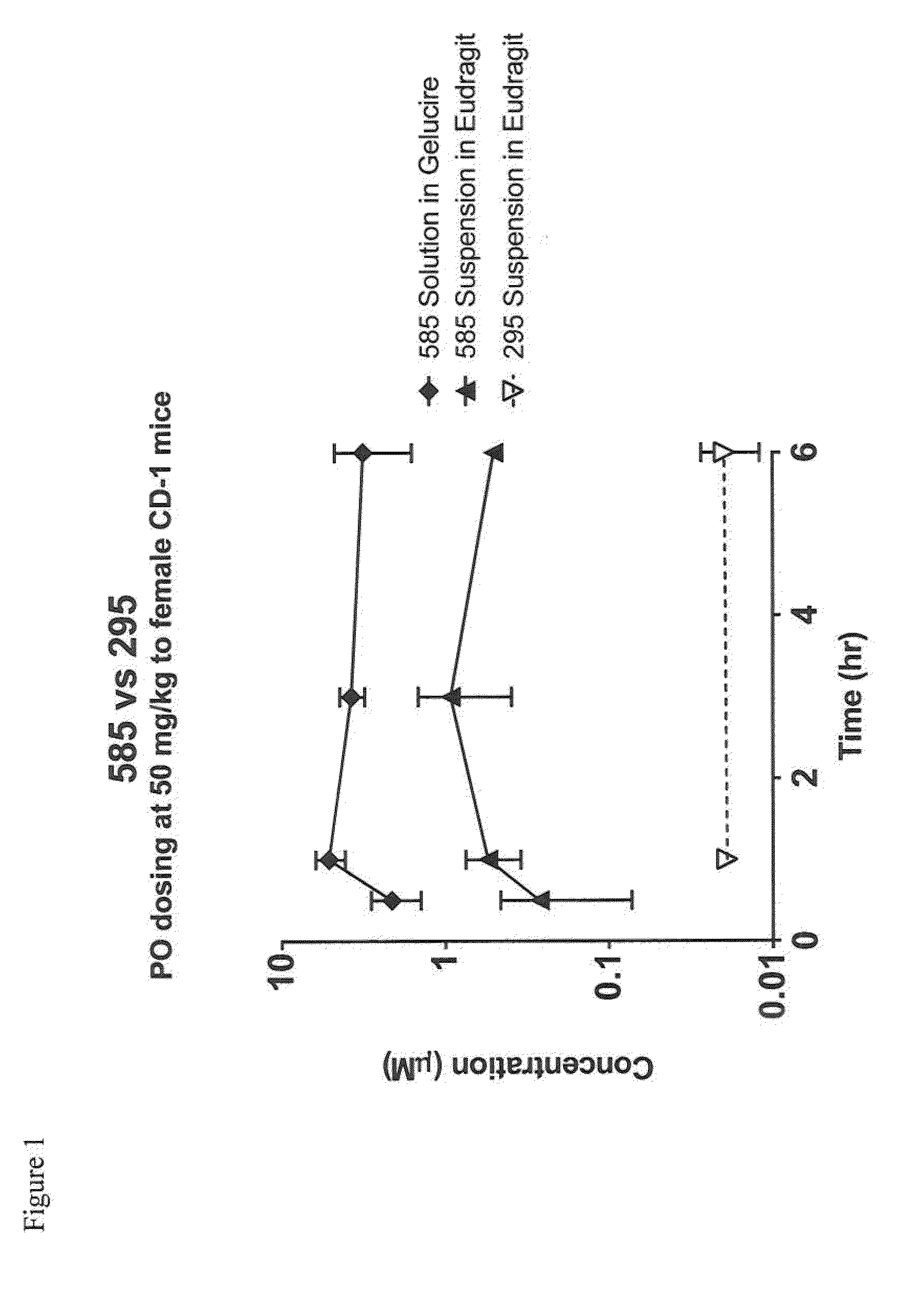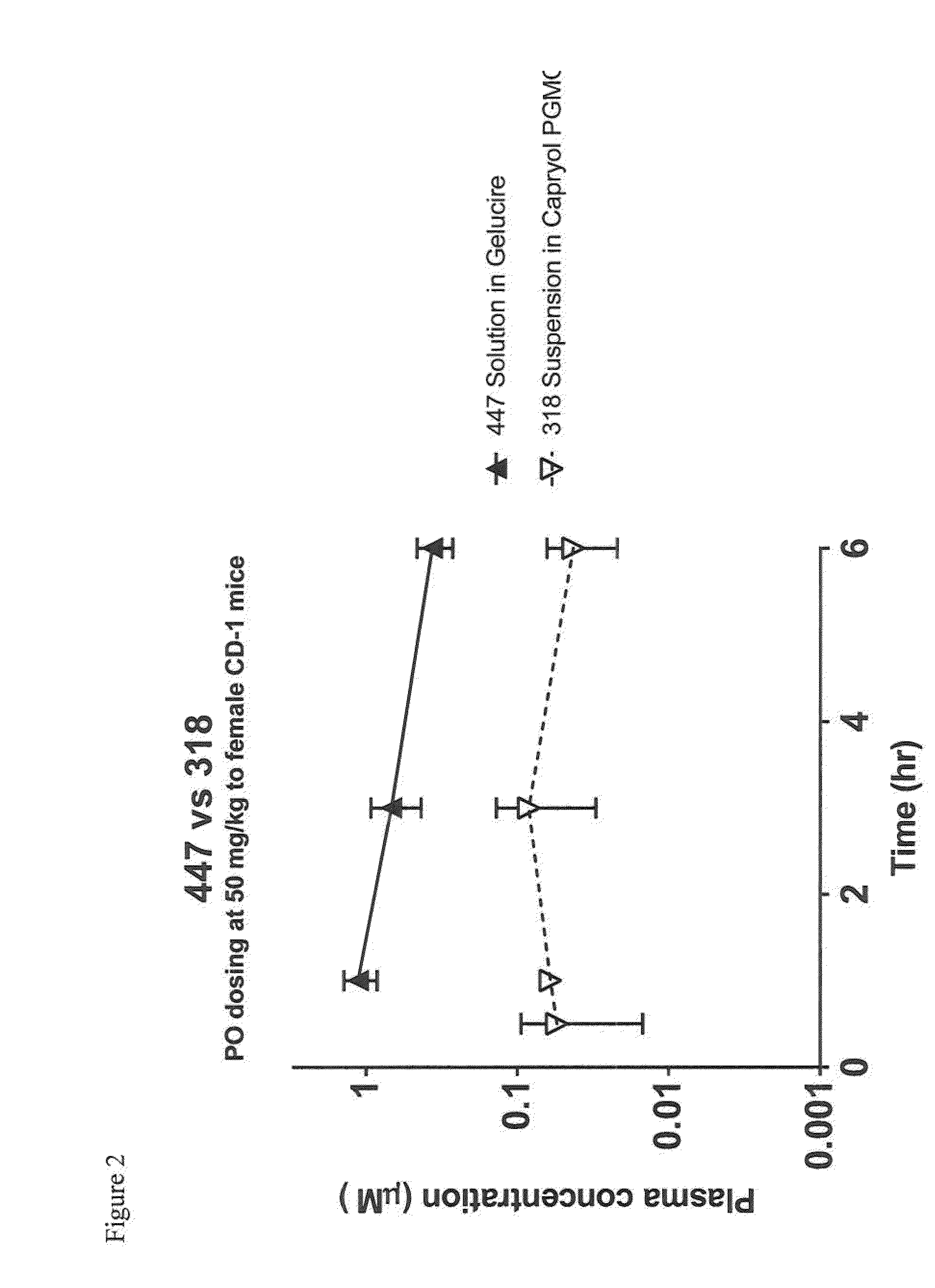Heterocyclic glutaminase inhibitors
a glutaminase inhibitor and heterocyclic compound technology, applied in the field of heterocyclic compound active ingredients, biocide, organic chemistry, etc., can solve the problem of impossible validation of this target, and achieve the effect of reducing tumor siz
- Summary
- Abstract
- Description
- Claims
- Application Information
AI Technical Summary
Benefits of technology
Problems solved by technology
Method used
Image
Examples
example 1
Synthetic Protocols
[0185]
[0186]To a suspension of 1019 (1.5 g, 6.8 mmol) in CH2Cl2 (15 mL) at 0° C. was added Et3N (1.9 ml, 13.6 mmol) dropwise followed by phenyl acetyl chloride (1.07 ml, 8.1 mmol) dropwise. The resulting mixture was stirred at 0° C. and then slowly warmed up to room temperature for 2 days. The crude material was purified by silica gel chromatography eluting with 0-25% EtOAc in hexane to afford 1020.
[0187]To a solution of 4-bromo-1-butyne (7 g, 53 mmol) in DMSO (30 ml) at 0° C. was added NaI (7.94 g, 53 mmol). The mixture was stirred at room temperature for 2 h before it was cooled to 0° C. and followed by addition of NaCN (5.2 g, 106 mmol). The resulting mixture was heated at 80° C. for 2.5 h and then stirred at room temperature overnight. The mixture was partitioned between water and EtOAc. The organic extract was washed with water, dried over sodium sulfate, filtered and evaporated to afford 1021.
[0188]To a mixture of 1020 (400 mg, 1.18 mmol), PdCl2(PPh3)2(41 mg...
example 2
Compound Assays
[0272]Compounds were assayed in both an in vitro biochemical assay and a cell proliferation assay as follows. The IC50 results are provided in Table 2.
[0273]Compounds were assessed for their ability to inhibit the enzymatic activity of a recombinant form of Glutaminase 1 (GAC) using a biochemical assay that couples the production of glutamate (liberated by GAC) to glutamate dehydrogenase (GDH) and measuring the change in absorbance for the reduction of NAD+ to NADH. Substrate solution was prepared (50 mM Tris-HCl pH 8.0, 0.2 mM EDTA, 150 mM K2HPO4, 0.1 mg / ml BSA, 1 mM DTT, 20 mM L-glutamine, 2 mM NAD+, and 10 ppm antifoam) and 50 μL added to a 96-well half area clear plate (Corning #3695). Compound (2 μL) was added to give a final DMSO concentration of 2% at 2× the desired concentration of compound. Enzymatic reaction was started with the addition of 50 μL of enzyme solution (50 mM Tris-HCl pH 8.0, 0.2 mM EDTA, 150 mM K2HPO4, 0.1 mg / ml BSA, 1 m...
example 3
Caco-2 Permeability Assay
[0283]Caco-2 cells are commonly used in a confluent monolayer on a cell culture insert filter. When cultured in this format and under specific conditions, the cells become differentiated and polarized such that their phenotype, morphologically and functionally resembles the enterocytes lining the small intestine. The cell monolayer provides a physical and biochemical barrier to the passage of small molecules, and is widely used across the pharmaceutical industry as an in vitro model of the human small intestinal mucosa to predict the absorption of orally administered drugs (Hidalgo et al., Gastroenterology, 1989; Artursson, J. Pharm. Sci., 1990). The correlation between the in vitro apparent permeability (Papp) across Caco-2 monolayers and the in vivo absorption is well established (Artursson et al., Biochem. Biophys. Res. Comm., 1991).
[0284]The present assay was used to determine the bidirectional permeability of the compounds of the invention through Caco-...
PUM
| Property | Measurement | Unit |
|---|---|---|
| temperature | aaaaa | aaaaa |
| temperature | aaaaa | aaaaa |
| temperature | aaaaa | aaaaa |
Abstract
Description
Claims
Application Information
 Login to View More
Login to View More - R&D
- Intellectual Property
- Life Sciences
- Materials
- Tech Scout
- Unparalleled Data Quality
- Higher Quality Content
- 60% Fewer Hallucinations
Browse by: Latest US Patents, China's latest patents, Technical Efficacy Thesaurus, Application Domain, Technology Topic, Popular Technical Reports.
© 2025 PatSnap. All rights reserved.Legal|Privacy policy|Modern Slavery Act Transparency Statement|Sitemap|About US| Contact US: help@patsnap.com



